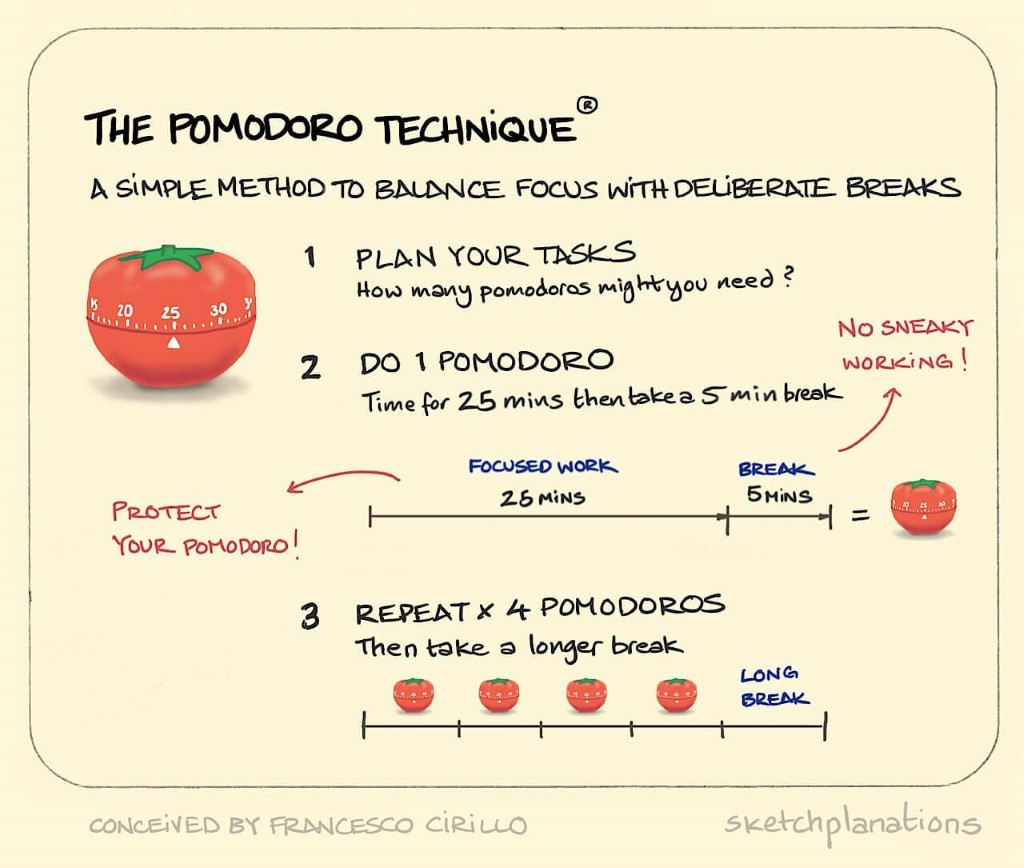Improve your productivity when working from home: The Pomodoro Technique.
23/06/2020

The global coronavirus lockdown has forced many people (PhD students included) to work from home for the first time, or for way longer than before. Some people have embraced this change readily, adapting to this ‘new normal’, other not so much. Working from home has many instant benefits; wear what you want (pyjamas?), choose your own hours, and no commute. But working from home also comes with plenty of distractions, whether it’s the TV, chores, raiding the fridge for the fourth time in 20 minutes, or learning a new song on the ukulele you panic-bought at the start of lockdown. Personally, I found it hard to adjust at first. I like to keep my work and home environment separate. When I walk through the door after a day in the office, I generally don’t think about work again until the following morning. Home is my place of rest. Being in lockdown and working from home has obviously disrupted this, and as a result I found myself being distracted, unmotivated and not very productive. Whatever your situation at home, you need tactics and strategies in place to help you work effectively.
The Pomodoro Technique

As the reality of working from home for the foreseeable future settled in, I decided to take some steps to improve the situation. Whilst reading an article not to dissimilar from this, I stumbled upon the Pomodoro Technique.
PC: Sketchplanation1
The Pomodoro Technique is a simple time-management system designed to improve productivity by breaking up time spent on tasks into small manageable units of time. Each interval is known as a ‘Pomodoro’, from the Italian word for ‘tomato’, after the tomato-shaped kitchen timer that inventor of the technique, Francisco Cirilo, used during his time at university.
How does it work?
The Pomodoro technique has a few simple steps.
- Choose a task to work on (or a smaller part of a large task)
- Set your timer for 25 minutes (25 mins = 1 Pomodoro).
- Work on the task for the duration of the Pomodoro, with no distractions.
- After the timer sounds take a short 5-minute break.
- Repeat this cycle (1-4) until you have completed 4 Pomodoro, then take a longer break (typically 20-30 minutes – good time for making some food)
Some notes and tips below:
- If you finish a task while the Pomodoro is still ticking, use the remaining portion of the Pomodoro to review or repeat what you’ve done, or make small improvements.
- I normally use one of the hundreds of Pomodoro timers available on the internet or in your device app store. Pro tip: If you’re tempted to scroll social media, I recommend using a desktop or in-browser timer and place your phone out of arms reach.
- Don’t cheat yourself out of a break! Be stubborn with yourself – get up out of chair walk around your house/apartment/room, get some air, do some stretches, make a cup of tea. Whatever it is, doesn’t matter, just no sneaky working! Enforcing these breaks gives you time to re-focus and assimilate the things you’ve just been working on.
- What if I get interrupted during the Pomodoro? You get a phone call or an urgent email? Does it need to be answered / replied to there and then? Can it wait until the end of the Pomodoro? If so, work through to the end of the interval and then respond afterwards – remember the whole point of Pomodoro is to be super focussed on work in short intense bursts.
- Of course, if you absolutely have to take a call or stop working, you have to reset the Pomodoro, and start the 25 minute cycle again. That’s how it work’s – I don’t make the rules.
And that’s it, simple!
Getting used to this enforced way of working took me some time, but after a day or two, it became natural. The Pomodoro Technique isn’t a magic method that will turn you into some superhuman work machine, but I have noticed a significant jump in my productivity. I’m less distracted, more focused, and able to complete task after task without feeling burned out. For me Pomodoro works as a self-discipline tool, allowing me to really get stuck into a task, rewarded with the pay-off of non-work breaks at the right times in my natural attention span (for most people this is around 20-30 minutes2). At the very least it adds some structure to an otherwise rather unstructured work/life balance.
I found Pomodoro at the right time of my PhD. I’m currently editing and revising a critical review paper, and starting to assemble and catalogue datasets for future experimental work, both type of task suited to Pomodoro structuring. This system has helped me to maintain productivity where it would have naturally waned throughout the day, whilst working on repetitive or text heavy tasks.
If you have found that, like me, you’re not happy with your lockdown productivity, I encourage you to give the Pomodoro technique a go.
2 Karen Wilson & James H. Korn (2007) Attention During Lectures: Beyond Ten Minutes, Teaching of Psychology, 34:2, 85-89, DOI: 10.1080/00986280701291291
Categories & Tags:
Leave a comment on this post:
You might also like…
Landing at Cranfield: First-term experiences and life beyond the classroom
Starting a postgraduate course can feel daunting, especially if you’re new to the aviation industry. In this blog series, Adit Shah shares his journey on the Air Transport Management MSc at Cranfield. From first-term ...
Accelerating ambition: How Amelie Rohan engineered her future at Cranfield
In the world of high-performance automotive engineering, the gap between being a “fan” and being a professional is measured in more than just miles. It is measured in technical precision, hands-on ...
Study better and smarter in 2026
Happy new year! Now is the perfect time to reflect on your studies so far, thinking about what you’re doing well and where you need to focus a bit more attention. Getting back into ‘study ...
Cleared for the future: Why aviation leaders must embrace environmental sustainability
Environmental sustainability is not a niche concern for aviation anymore, it’s central to how we think about the future of our industry. In my work as an Associate Professor of Airport Decarbonisation, I see first-hand ...
Preparing your work for Turnitin submission
Before submitting your work into Turnitin for similarity checking, if you have used referencing software then you may need to take some important steps first. Mendeley and Zotero integrate with MS Word by embedding field ...
The fast track to supercar engineering: My Cranfield journey
It’s been a dream come true to work on some of the world’s most prestigious supercars – the Aston Martin Valhalla, McLaren 750 & Artura, the GMA T.33. But every successful ...






